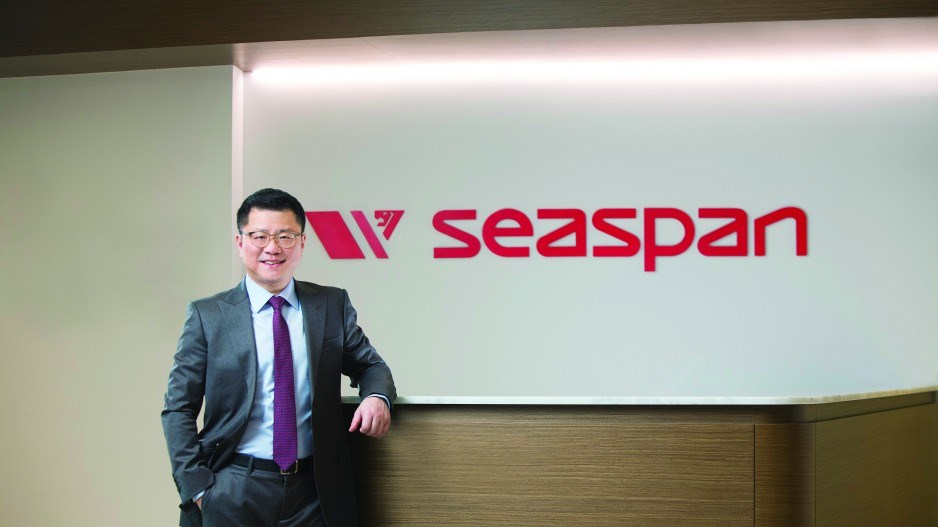The world’s largest independent container ship charter owner and manager just got larger.
Vancouver’s Seaspan Corp. (NYSE:SSW) has acquired the 89% of Greater China Intermodal Investments LLC (GCI) that it did not own in a US$1.6 billion acquisition that adds 18 ships to its fleet of 94 and US$1.3 billion to Seaspan’s contracted revenue, which will now be approximately US$5.6 billion.
The GCI deal closed in mid-March.
Seaspan has four major offices around the world, one of which is in Vancouver.
The global ship management and container ship leasing company also announced that it has secured a US$250 million investment from Fairfax Financial Holdings Ltd.
Company CEO Bing Chen told Business in Vancouver that the GCI acquisition adds a diverse set of large and relatively new ships to the company’s fleet.
“[The GCI acquisition] gives us the best asset available in the market,” Chen said.
Calling it the right deal at the right time, he added that the acquisition also represents a move toward consolidation in an extremely fragmented container ship leasing and management sector.
Chen said pooling shipping resources will help Seaspan provide a more effective and diverse service to a global container carrier sector that itself has been consolidating via a wave of mergers and alliances over the past two years.
According to Chen, the GCI acquisition gives Seaspan an 8% share of the global container ship leasing and management sector, up from around 6.5% prior to the deal. He said the next biggest player in the sector has a 5% market share.
Because Seaspan has been managing GCI’s fleet, the acquisition comes with virtually no corporate integration costs.
Chen succeeded longtime Seaspan CEO Gerry Wang, who retired in early November 2017 after 20 years with the company.
Chen has lengthy experience in banking and commodity trading but no previous experience in the container shipping and vessel-leasing industry. He joined Seaspan in January.
The GCI acquisition follows the release in late February of Seaspan’s fiscal 2017 results, in which the company reported a slight increase in fourth-quarter revenue compared with the same quarter in 2016, but a 5.3% decrease in revenue to US$831 million for the year ended December 31, 2017, compared with fiscal 2016. Fiscal 2017 earnings dropped to US$141 million from US$172 million in 2016.
The company attributed the lower revenue in part to lower rates for short-term ship charters.
During a February 28 earnings call, Peter Curtis, Seaspan’s chief commercial and technical officer, noted that containerized trade growth in 2017 was 6.6%, “the highest level in six years.”
Curtis said global container throughput growth has outstripped the growth of the world’s container fleet since the end of 2015, and that the two are expected to be close to each other this year.
He added that the global idle fleet is around 1.4% or 300,000 20-foot equivalent units (TEUs) of the total.
Earlier this year, U.K. shipping consultancy Drewry upgraded its forecast for global container cargo growth to 4.3% from 3.6% for 2018, which it pointed out will mark the second year running in which there will be growth in every region of the world.
However, container rates on such key trading routes as the transpacific remain under stress in a sector that continues to struggle with overcapacity.
Global container shipping capacity increased 3.9% in 2017 to 22 million TEUs, according to Alphaliner. The shipping data company has noted that capacity on the transpacific trade route is expected to jump by at least 8% by July. That could continue to erode transpacific container shipping rates, it warned.
Seaspan has also struggled.
Shipping industry analyst J. Mintzmyer, writing in his Seeking Alpha blog, said Seaspan has been suffering from “weaker market sentiment combined with a lack of investor support due to unexplained dilution.”
He pointed out that the GCI acquisition also increases Seaspan’s exposure to Yang Ming Marine Transport Corp. (TPE:2609), the financially stressed Taiwan-based shipping liner company that makes up 46% of GCI’s customer base.
Yang Ming previously accounted for 18% of Seaspan’s charter clientele. The GCI acquisition increases that to 24%.
While Yang Ming’s financial results for 2017’s first half showed an 87% reduction in net loss compared with the same period in 2016, that loss was still US$44 million. By year’s end, however, company finances were back in the black with a US$10.8 million profit on revenue of US$4.4 billion.
In Seaspan’s March 20 GCI acquisition conference call, Chen said he was optimistic about the continued recovery of the global container shipping industry.
But he later conceded to BIV that the sector is in a transformation phase and continues to be oversupplied.
“So there is pressure in a cycle of excess capacity,” he said. “Smaller asset owners don’t have the necessary capital, the scale, the flexibility and expertise to provide the type of services that our customers [major container liner companies] require. A service provider like us, to be able to provide … reliable, flexible and creative solutions to [meet] their business needs – that is the biggest challenge and also an opportunity.”




